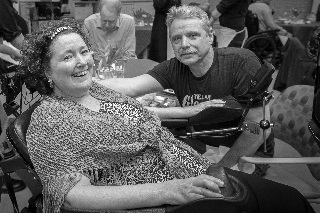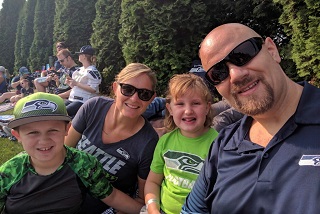Bailey-Boushay House Homefront Newsletter
November 2017 Edition
Inside this issue
For the Love of Tina's Smile | Giving Back in Many Ways | November 28 is #GivingTuesday
For the Love of Tina’s Smile
 |
|
Tina and her husband Rod enjoyed going to
Bailey-Boushay House's many gatherings.
|
When Tina was in the late stages of amyotrophic lateral sclerosis (ALS) or Lou Gehrig’s disease, she couldn’t find a nursing home equipped to deal with her many needs. But when a space opened, Bailey-Boushay House (BBH) welcomed her. “We didn’t expect her to live very long when she entered Bailey-Boushay,” says her husband Rod. “But she lived for two and a half years. That never would have happened anywhere else.”
Tina passed away August 17, 2017. She left behind Rod and a daughter, Jennifer, who loved her and supported her through the trials of a devastating and destructive disease. She also left behind a Bailey-Boushay House family whose care and devotion nurtured Tina’s spirit even when her body no longer functioned, and her mind was gripped by end-stage dementia. “Tina taught us so much about ALS and meeting individuals where they are at,” says BBH Executive Director Brian Knowles. “Tina was filled with passion, even when she was not able to move, she could convey her feelings of joy, love and disappointment with a single look. Tina pushed the staff to know the person behind the patient. The love from her family, especially her husband Rod who visited almost every night, was life affirming.”
Going the Extra Mile
Bailey-Boushay House team members are always learning and working to do better. In 2015, 10 staff members spent a week at an innovation event working to improve patient care. During the event, engineer Tate Downs noticed that Tina’s stand for her communication device sometimes got in the way of her patient care.
Tina’s device, called a Tobii, uses a screen to enable eye sensing technology for communication. By gazing at various icons on the screen, Tina could generate speech, link to the internet, play music, watch movies and write on her blog. Because it relies on direct alignment with her eyes, anything that bumps or moves the device requires a long, sometimes frustrating reset process.
“Tina’s Tobii was her one link to communication and really her life, and people were afraid of knocking it,” says Tate. “Tina has a great smile and I just wanted to see that joy on her face knowing that her Tobii would always be in the right place. I came up with the idea of having it hang down from the rolling bars around her room.”
The bars are there to move her around the room when needed. Tate and occupational therapist Marni Hanig developed several prototypes over a year. Tate is now customizing the “Rolling Tobii” for another client who is a serious gamer and more devices are being ordered for other rooms.
Daily Care – A Matter of Trust
Daily care for ALS patients with frontotemporal dementia, a common end-stage complication with ALS, is an ongoing challenge for BBH team members. The disease causes changes in behavior and personality. “It’s like having OCD without the ability to act on it,” says BBH Director of Nursing Martha Purrier. “Tina would want everything in a special way and in a certain sequence, but because of the dementia, the order would change all the time. She would lose her patience with us and ‘fire’ us by telling us to get out of the room. We learned that we had to assure her she was safe and rebuild her trust in us so we could come back.”
Martha recalls the creative ways Tina’s care team brought joy to their patient. “We’d rebuild trust by sharing with her and giving her special moments,” says Martha. “We scouted out a route to have her and her husband see the holiday lights. She loved to take baths so we’d arrange for two to three people help her take a bath with bath oils several times a week, taking several hours each time, but it was worth it to see her smile.” .
Making Special Moments
 |
|
Tina and Angela Brock, occupational therapist, attend homecoming festivities at Bailey-Boushay House.
|
“Tina was a gourmet cook and loved good food,” says her husband Rod. “The chef made special dinners including an Italian night that meant a lot to her. I’m very grateful for everyone who cared so much for her.”
Team members also arranged a visit to the Cat Café and visits from therapy dogs because she enjoyed animals. She attended dances and the BBH prom. “She had some wonderful moments, she lived her life until she left,” says Angela Brock, BBH occupational therapist. “I remember Jordan, one of our volunteers, knitting in her room because Tina loved to knit, and the music therapist playing the harp while I was working on stretching her body out. It was a beautiful moment.”
An Adventurous Woman
“Tina and I would talk about the photographs in her room,” says Talita Haywood, a patient care technician who cared for Tina the entire time she was a resident. “She was such an adventurer and traveler. She and Rod rode Harley Davidson motorcycles and she took trips with her daughter. I really miss her personality and her family, they were very dedicated. She was an awesome woman and we all miss her.”
A Commitment to ALS Patients
“Many nursing homes won’t take people with ALS who need full care and can’t move any muscles in their body,” says Brian Knowles, Executive Director. “At this stage they also have paranoia and the challenges that come with it. We will take these patients.”
At times Bailey-Boushay House (BBH) has more people with ALS than any nursing home in the state, usually caring for three or four residents with ALS, with an average stay time of about a year. While BBH’s 35-bed nursing home provides care primarily for HIV/AIDS residents, whenever there are beds available, they are offered to people with degenerate nerve disease, including ALS, Huntington’s disease, muscular dystrophy and multiple sclerosis. ALS is a progressive and incurable disease that affects the nerves in the brain and spinal cord that control the muscles. As the muscles get weaker, patients lose the ability to walk, talk, swallow and even breathe.
“We’re well-suited to care for them because they need a great deal of support and we have some of the highest staffing levels in the state,” says Brian. “We also understand how to help people at end-of-life, especially younger people.”
Back to Top
Giving Back in Many Ways
 |
|
Melissa, Darren and family.
|
Melissa describes Bailey-Boushay House as a place of unconditional love and support, regardless of anyone’s background. After her experience volunteering at Bailey-Boushay, Melissa and her husband, Darren, decided to donate. Darren works at Microsoft and they’ve contributed to Bailey-Boushay House through the Microsoft Giving Program every year since they were married in 2006.
“Bailey-Boushay House is so close to my heart, I couldn’t think of a better organization to donate,” says Melissa. “The support and love I saw BBH staff members give their patients was amazing. All people suffering from a life-threatening illness should receive that level of compassion.”
Volunteering in Adult Day Health
Melissa volunteered at Bailey-Boushay House while attending Washington State University as a way to give back in support of a close friend living with HIV. “Most of my time was spent taking BBH clients to and from doctors’ appointments, getting their medications or transporting them back to BBH,” says Melissa. “I look back on those days very fondly. It enriched my life in more ways that I can express. The people I got to know were amazing.”
Participating in Microsoft Giving Program
“I’m a working mother now and I wish I could volunteer, but giving still allows me to be part of BBH,” Melissa explains. “We donate through the Microsoft Giving Program because they match our donation, doubling what we give. It’s easy to set up and do.”
Darren is a senior network engineer at Microsoft and Melissa is a special education teacher in the Renton School District. They have two children, Liam in fourth grade and Regan in kindergarten. “We love spending time outdoors, traveling and rooting on the Seahawks,” says Melissa.
It’s the generosity of people like Darren and Melissa who continue to make a life-changing difference in the lives of Bailey-Boushay House clients and residents.
Back to Top
November 28 is #GivingTuesday
The people who receive their care at Bailey-Boushay House are counting on you. Next year, clients will need 2,700 bags of groceries, 8,200 sack dinners and 13,000 pairs of socks.
Luckily, we have an opportunity to help meet these needs right now, on #GivingTuesday!
#GivingTuesday is a global giving movement built by individuals, families, organizations, businesses and communities worldwide. It’s also the opening day of the giving season: a reminder of the “reason for the season.”
Please remember the deserving people at Bailey-Boushay House and join us on Tuesday, Nov. 28 for #GivingTuesday.
Back to Top